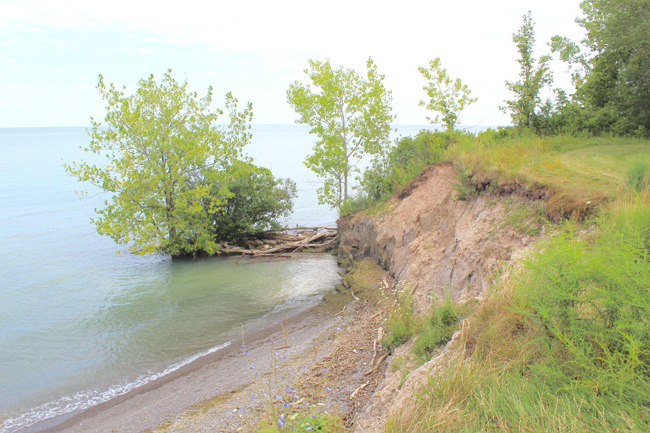
The shoreline along Lake Ontario in Niagara County are often bluffs. High and steep, erosion is an issue for the structures above them.
— Filed by Benjamin Joe for the Lockport Union-Sun & Journal
May 3, 2023 — The threat of erosion of Lake Ontario’s shoreline is a serious issue for property owners. For example, in Krull Park in Olcott, a historic amphitheater was at risk of falling into the lake, and there is now a $4 million effort underway to save it and the surrounding shoreline.
New York Sea Grant, an almost 50-year-old nonprofit organization, wants to get the word out to lakefront property owners that it has helpful information for them.
“What we do is let them know what their options are,” erosion specialist Roy Widrig said.
Widrig said he visits lakefront properties all the time and in Niagara County they are bluffs. Steep and high. The danger is waves of water digging underneath houses, and higher waves are expected in the near future.
“Right now we’re coming into an El Nino cycle,” Widrig said. “They usually last one to three years.”
Widrig said that while Lake Ontario has a lower water depth, in an El Nino cycle, all seasons including winter will be warmer and wetter. This sets up a situation in which ice, which normally protects the shoreline from waves in winter, will not exist.
So, what’s a lakefront property to do?
Widrig said some people don’t want any construction on their shoreline; they would prefer to use plant species that strengthen the soil instead of pouring concrete or placing large stones to break up those eroding waves.
“A lot of people enjoy a natural shoreline,” Widrig observed. In that situation, he said, New York Sea Grant doesn’t push any kind of action.
“We just provide information: How, why and when whatever happens, happens,” he said.
For those not opposed to construction, Widrig recommends terracing. That’s creation of a gradual descent from the shore into the lake and placement of a barrier of stone or concrete slab at the final point between land and water. This will stop property from falling into the lake, he said. The downsides are limited access to the water and the elimination of summer wading, since wave action will dig up soil ahead of the slab.
If that’s the way a property owner wants to go, New York Sea Grant can provide quick connection to the New York State Department of Environmental Conservation’s permitting division, which has to sign off on construction, Widrig said.
New York Sea Grant assists property owners at no charge. It’s not a government agency, but it does get federal and state funding. It’s one of more than 30 organizations across the country that offer information about soil erosion. For more information call 315-312-3042.
More Info: New York Sea Grant
New York Sea Grant (NYSG), a cooperative program of Cornell University
and the State University of New York (SUNY), is one of 34 university-based
programs under the National Oceanic and Atmospheric Administration’s
National Sea Grant College Program.
Since 1971, NYSG has represented a statewide network of integrated
research, education and extension services promoting coastal community
economic vitality, environmental sustainability and citizen awareness
and understanding about the State’s marine and Great Lakes resources.
Through NYSG’s efforts, the combined talents of university scientists
and extension specialists help develop and transfer science-based
information to many coastal user groups—businesses and industries,
federal, state and local government decision-makers and agency managers,
educators, the media and the interested public.
The program maintains Great Lakes offices at Cornell University, SUNY
Buffalo, SUNY Oswego and the Wayne County Cooperative Extension office
in Newark. In the State's marine waters, NYSG has offices at Stony Brook
University in Long Island, Brooklyn College and Cornell Cooperative
Extension in NYC and Kingston in the Hudson Valley.
For updates on Sea Grant activities: www.nyseagrant.org has RSS, Facebook, Twitter, Instagram, and YouTube links. NYSG offers a free e-list sign up via www.nyseagrant.org/nycoastlines for its flagship publication, NY Coastlines/Currents, which is published quarterly.